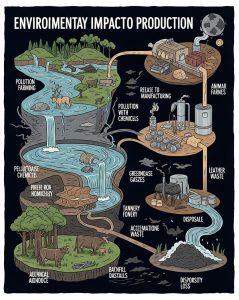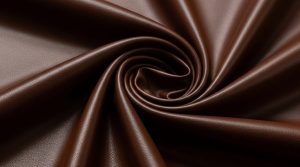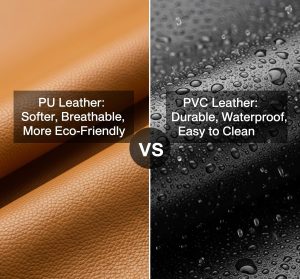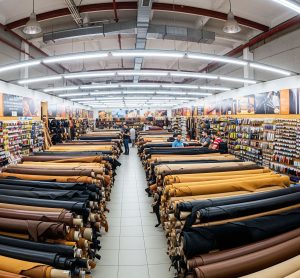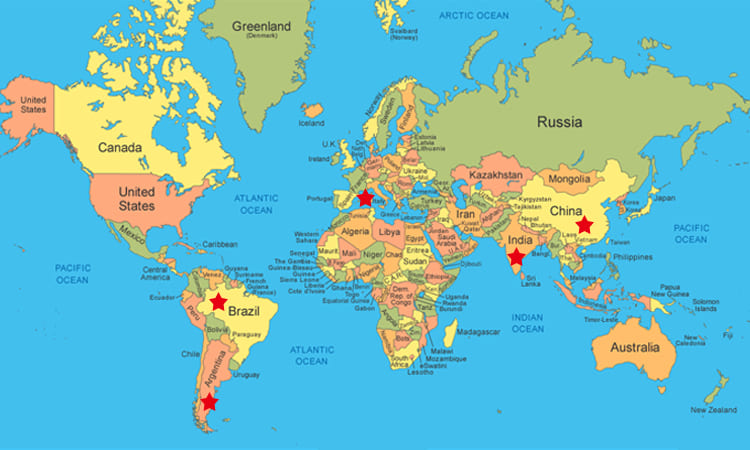
버터처럼 부드러운 가죽 재킷이나 매끈한 가죽 핸드백이 어디서 시작되었는지 궁금하신가요? 스포일러를 드리자면, 이탈리아의 멋진 공방에서 장인이 만든 것이 아닙니다(물론 가끔은 그렇기도 하지만요!). 가죽은 브라질의 광활한 소 목장에서 시작하여 분주한 공장으로 이동하는 진정한 글로벌 스토리를 가지고 있습니다. in China, and lands in luxury boutiques in Italy. Whether it’s mass-produced for everyday goods or meticulously tanned for high fashion, leather manufacturing spans continents, blending ancient craftsmanship with modern industry. So buckle up (in your finest leather belt, of course) as we take a world tour of the top leather-producing countries, from farm to factory!
글로벌 가죽 허브: 가죽은 어디에서 생산되나요?
가죽은 전 세계에서 제조되며, 장인 정신과 대규모 생산으로 유명한 몇몇 주요 지역이 있습니다. 유럽, 아시아, 남미에는 각각 고유한 전문성과 기술을 갖춘 최대 규모의 가죽 산업이 자리 잡고 있습니다. 예를 들어 이탈리아는 특히 패션 및 명품 분야에서 프리미엄 고품질 가죽으로 유명합니다. 반면 중국과 인도 같은 국가는 대량 가죽 생산을 선도하며 내수용 및 수출용 가죽 제품을 다양하게 공급하고 있습니다. 브라질과 아르헨티나 같은 남미 국가들도 가죽 제조에 필요한 풍부한 원료를 공급하는 대규모 축산업 덕분에 주요 업체로 부상하고 있습니다. 이러한 글로벌 허브들은 고급 패션과 일상 소비재 모두를 충족하는 방대하고 다양한 가죽 산업에 기여하고 있습니다.
농장에서 공장까지: 최고의 가죽 제조 국가
가죽 생산에 있어서는 몇몇 국가가 세계 시장을 지배하고 있습니다. 특히 명품 부문에서 뛰어난 장인 정신으로 인정받는 이탈리아가 선두에 서 있습니다. 예를 들어 토스카나 가죽은 풍부한 질감과 수백 년의 전통에 기반한 태닝 공정으로 높은 평가를 받고 있습니다. 그러나 중국은 전 세계 가죽 제품의 상당 부분을 생산하며 생산량 면에서 세계를 선도하고 있습니다. 인도는 광범위한 축산업과 숙련된 노동력으로 유명한 또 다른 주요 제조업체로, 완제품 가죽과 가죽 제품 모두에 중요한 공급업체입니다. 브라질과 아르헨티나도 번성하는 축산업 덕분에 전 세계 가죽 생산에 크게 기여하고 있습니다. 이 국가들은 생가죽을 생산할 뿐만 아니라 패션 액세서리부터 자동차 내장재에 이르기까지 특정 유형의 가죽 제조에 특화되어 있습니다.
가죽 강국들: 가죽 생산의 선두 국가
이탈리아, 중국, 인도, 브라질은 세계 가죽 시장에 막대한 기여를 하고 있기 때문에 흔히 가죽 강국이라고 불립니다. 이탈리아는 고급 장인 가죽 제품의 대명사이며, 특히 패션 및 명품 브랜드를 위한 세계 최고급 가죽을 생산하는 태너리(제혁소)로 존경받고 있습니다. 반면 중국은 가죽 가공 및 제조 분야의 선두주자로, 합리적인 가격과 규모 있는 생산 능력을 갖추고 있습니다. 인도는 무두질과 가죽 제품 생산에 주력하며 많은 인력과 방대한 소 자원의 이점을 바탕으로 그 뒤를 바짝 쫓고 있습니다. 브라질은 거대한 축산업을 바탕으로 대량의 생가죽을 생산하여 전 세계 시장에 가죽 및 가죽 완제품을 수출하고 있습니다. 이 두 국가는 함께 가죽 산업의 지형을 형성하고 있으며, 각기 고유한 강점을 가지고 있습니다.
전통과 산업이 만나는 곳: 전 세계 가죽 제조
가죽 제조는 수 세기에 걸쳐 전통과 현대 산업 관행을 결합하여 진화해온 고대 공예입니다. 이탈리아와 스페인과 같은 지역에서는 가죽 생산이 역사에 깊이 뿌리를 두고 있으며 장인의 기술이 여러 세대에 걸쳐 전승되고 있습니다. 특히 토스카나 지방의 이탈리아 가죽은 나무 껍질과 같은 천연 재료를 사용하는 식물성 태닝 공정으로 유명하며, 수백 년 된 장인 정신을 보존하는 동시에 럭셔리 시장의 요구를 충족합니다. 반면 중국과 인도와 같은 국가는 전 세계 수요를 충족하기 위해 대량 생산 기술을 사용하는 산업적 측면의 가죽 생산을 대표합니다. 이러한 차이에도 불구하고 장인적 접근 방식과 산업적 접근 방식 모두 오늘날의 가죽 시장에서 자리를 잡았으며, 전통과 산업이 공존하여 다양한 소비자 니즈를 충족시킬 수 있는 방법을 보여주고 있습니다.
지도로 보는 가죽: 가죽 생산의 주요 지역
가죽 생산의 세계 지도에는 몇 가지 주요 지역이 눈에 띄며, 각 지역이 가죽 산업에 고유한 기여를 하고 있습니다. 유럽, 특히 이탈리아와 스페인은 세련된 태닝 기술과 장인 정신으로 패션 및 명품에 사용되는 고품질 가죽의 대명사입니다. 중국과 인도를 중심으로 한 아시아는 신발부터 자동차 내장재까지 다양한 가죽 제품을 생산하며 규모 면에서 압도적인 우위를 점하고 있습니다. 라틴 아메리카, 특히 브라질과 아르헨티나는 대규모 축산업으로 인해 생가죽과 무두질 가죽의 공급처로서 중요한 역할을 하고 있습니다. 각 지역은 생가죽 생산부터 완제품 명품에 이르기까지 가죽 공급망의 다양한 측면에 특화되어 있어 전 세계 가죽 무역에서 필수적인 역할을 담당하고 있습니다.
이탈리아에서 인도까지: 가죽 제조의 주요 업체들
이탈리아와 인도는 가죽 제조 분야에서 가장 중요한 두 국가이지만, 시장의 다른 부문을 공략하고 있습니다. 이탈리아는 장인 정신과 고급 핸드백, 신발, 액세서리에 사용되는 고품질 제품으로 유명한 세계 최고급 가죽 생산지로 유명합니다. 이탈리아의 제혁소는 세심한 공정으로 유명하며, 특히 토스카나 가죽이 높은 평가를 받고 있습니다. 반면에 인도는 세계 최대의 가죽 생산국 중 하나로, 생가죽 가공과 다양한 가죽 제품 제조로 유명합니다. 인도의 가죽 산업은 저렴한 제품과 프리미엄 소재를 모두 제공하며 글로벌 공급망에 중요한 역할을 하고 있습니다. 이탈리아는 고급스러움과 전통에 중점을 두는 반면, 인도는 다양성과 규모에 강점을 가지고 있어 두 나라 모두 가죽 산업에서 없어서는 안 될 중요한 국가입니다.
결론: 결론: 글로벌 가죽 여정 - 목초지에서 제품까지
가죽이 생가죽에서 세련된 제품으로 탄생하기까지의 여정은 대륙과 문화, 수세기에 걸쳐 있습니다. 이탈리아의 고급스러운 수작업 무두질 가죽부터 중국과 인도의 대량 생산까지, 전 세계 가죽 산업은 전통과 혁신을 결합합니다. 브라질의 소 목초지에서 스페인의 장인 공방에 이르기까지 각 국가는 우리가 알고 사랑하는 가죽 제품을 만드는 데 있어 고유한 역할을 하고 있습니다. 소비자로서 우리는 이 세계적인 이야기의 일부이며, 일상적인 가죽이든 최고급 명품이든 가죽은 단순한 소재가 아니라 여러 세대에 걸쳐 완성된 세계적인 공예품이라는 점을 기억하세요.




